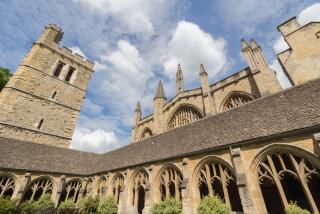International House Draws Mix of Residents : Foreign Students Find a New Home in the U.S.
- Share via
NEW YORK — Manhattan’s Upper West Side can be a tough place. Tough to walk through, tough to live in, and tougher still for foreigners trying to get an education.
But perched atop one of Manhattan’s highest points overlooking the Hudson River and Grant’s Tomb, there’s a place that provides food, shelter and an atmosphere where students from all over the world can learn about life in the United States.
It’s called International House.
I. House, as it is generally referred to, is a dorm-style residence where on any given floor there may be students from as many as 15 to 20 countries. A third of its residents are American.
Students pay about $300 a month for small rooms and married couples pay about $500 for apartments.
Curtis Ingraham, who has lived there for the past two years, says the residents’ rooms were made small and the meeting rooms large purposely so the students would come out and mingle.
The 530 students who live here are in New York City to further their education in graduate schools at Columbia and New York universities, City University of New York, Parsons School of Design, Juilliard and Manhattan schools of music.
More than 2,000 students apply annually to the nonprofit house, supported by individuals, foundations and corporations. International House’s yearly budget runs to about $4 million.
I. House is more than just a place to eat, sleep and study. It is a place where foreign students live with Americans to learn more about life in the United States, says Nancy Cooper, director of development and alumni affairs. “Many warm friendships--and marriages--have been made,” she says.
Svava Bernharsdottir, 24, a viola player, is from Iceland and has two more years at Juilliard. She says New York is a wonderful place to study. “I’ve gone to concerts I never would have dreamed of going to. You have the whole world in a nutshell. I’ve talked to people from Africa to Salvador. I’ve become a well-rounded person.”
Spiros Branis came from Greece to get his master’s degree in physics at the New York City University Graduate Center. His tuition and living expenses are being paid by the city of New York. In return, he teaches physics to nursing students at City College. He also earns minimum wage at the house as an equipment technician.
International House was the dream of Harry Edmonds, a former secretary of the YMCA, who died in 1979 at the age of 96. Edmonds had begun playing host to small gatherings of foreign students in 1909. He got the idea after a Chinese student thanked him for being the first person to speak to him since his arrival in New York three weeks before.
By word of mouth, the gatherings grew and Edmonds had to find other meeting places. In 1920, he enlisted the help of John D. Rockefeller Jr., who gave almost $3 million for the Upper West Side site and the building itself.
Mrs. Rockefeller designed and furnished the house, a stately building with meeting rooms with high ceilings and panelled walls.
In 1924, International House in New York City was opened, and in 1930 the Berkeley, Calif., House was opened, followed by the Chicago House and the Paris House. More than 60 International Houses and Centers now operate worldwide.
American students may stay in the house here one year and foreign students are allowed two. Those who are awarded fellowships may stay an extra year.
Eighteen resident fellows are on hand from 9 p.m. to midnight every night to help students. They are also responsible for arranging the many, varied programs that go on in the house.
There’s the “Night of Nations” festival in the spring when visitors sample everything from Belgian waffles to tacos while listening to calypso, bluegrass and jazz music at booths set up by the residents.
In addition to a literary magazine, photography club, and a 60-piece orchestra, activities include serving the community. The Harlem Tutorial program enlists the aid of residents to tutor fourth- and sixth-graders from New York’s Public School 125.
There’s also a ham radio club that enables students to call their families and friends around the world, and a pub that has more varieties of beer than most bars in Manhattan.
More to Read
Sign up for Essential California
The most important California stories and recommendations in your inbox every morning.
You may occasionally receive promotional content from the Los Angeles Times.










